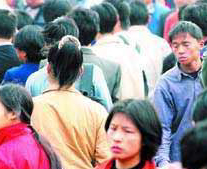
China's urban population is expected to reach nearly 560 million by the end of this year, a jump of 7 percent from the figure five years ago, a senior official said on Friday in Beijing.
By the end of 2005, 43 percent of China's population will be living in urban areas, said Zheng Xinli, deputy director of the Policy Research Office of the Central Committee of the Communist Party of China (CPC).
During the 10th Five-Year Plan (2001-05) period, the average urbanization growth rate was 1.4 percent annually, Zheng said at a forum on the sustainable development of small and medium-sized cities in China.
The rapid urbanization process has prodded Chinese policy-makers to pay more attention to small and medium-sized cities, which are the main places for accommodating urban dwellers on the Chinese mainland.
China has 660 cities on the mainland, and more than half of them are small and medium-sized ones. Medium-sized cities have a population of 200,000 to 500,000 people.
This rapid urbanization has put great pressure on the environment and sustainable development is urgently needed, according to Wang Yangzu, former vice director of the State Environmental Protection Administration (SEPA).
Official statistics show that a total of 297 Chinese cities do not have special sewage treatment plants, most of them small and medium-sized cities.
The forum, organized by the Urban Development and Environment Research Center with the Chinese Academy of Social Sciences (CASS) over the weekend, chose 10 small and medium-sized cities as model cities for energy-saving and environment-friendly practices. These cities, including Zhangjiagang, Kunshan and Pingdu, are predominately located in coastal provinces such as Jiangsu, Zhejiang and Shandong.
The high consumption rate of natural resources, such as energy, mineral resources, water and land, has restrained China's sustainable development, said Liu Weixin, a researcher with CASS.
(China Daily December 17, 2005)
|

